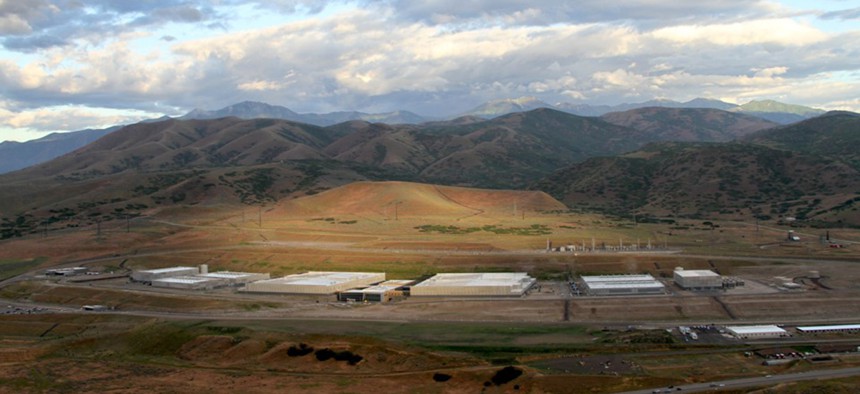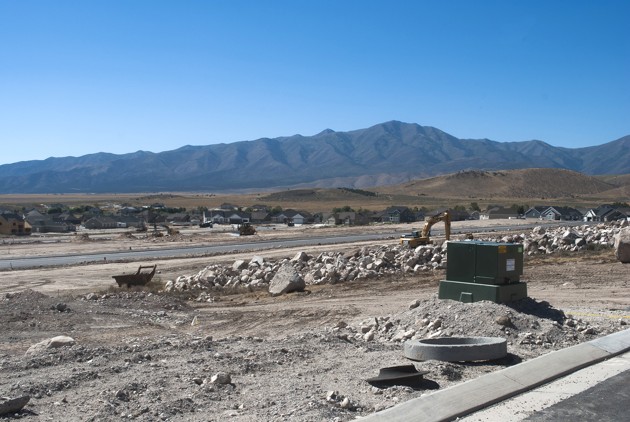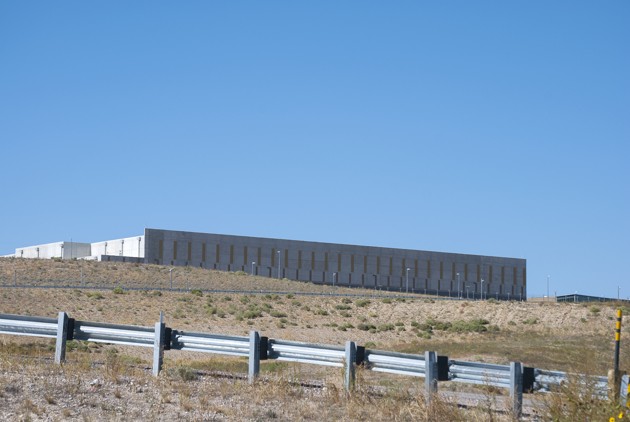Why Is NSA's Largest Data Center in the Middle of a Desert?

NSA's data center in Bluffdale, Utah Wikimedia
Taking a trip to the agency's largest surveillance storehouse.
When I told friends that I'd be driving across America to find The Cloud, many of them brought up the NSA's Utah data center, assuming it was on my itinerary. Which was understandable—since 2013, it's become a monument to the anxieties of big data and mass surveillance, a black box just out of reach and far beyond comprehension.
I tended to respond to these friends with a little bit of fatigue. It's not that I don't care about the NSA Data Center. It’s just that every good story about driving to see the NSA Data Center has been written. It's the infrastructure/national-security writer equivalent of the “Why I'm Leaving This Interesting, But Expensive City” essay. Most of them were written right after the first Snowden stories started dropping, taking advantage of the (slightly) more lax security before the data center became fully operational. Kashmir Hill probably did it best.
But these stories rarely explored why the NSA Data Center was in Utah, a decision that doesn’t seem to make much sense, at first glance. Most intelligence agencies’ headquarters are in northern Virginia and Maryland. The only other well-known western outpost of intelligence operations, the Texas Cryptologic Center in San Antonio, is about 1,200 miles away from Bluffdale.
As stories about the building's frequent problems with power and water usage came out, the choice seemed even weirder and more arbitrary. Why put the infinite archive of state surveillance in a place so vulnerable to drought? What was the appeal? I kept these questions in mind as I went on my own reluctant pilgrimage to the Salt Lake region's other prominent temple to a controversial faith with a questionable origin story.
* * *
I drove to Bluffdale from Wendover, a town on the Utah-Nevada border that is home to, among other things, the first transcontinental telephone call and an airplane hangar that once housed the Enola Gay. This particular stretch of route 80 in northern Utah is a landscape narrated by Werner Herzog—vast expanses of crystallized white salt against hazy white skies, most of it home to unseen Department of Defense operations. The Hill Air Force Base, the Utah Test and Training Range, the Dugway Proving Ground, and the Tooele Chemical Agent Disposal Facility all call this stretch of wasteland home, in part because there is enough empty space to do things like chemical weapons testing and drone-pilot training.

These many DoD outposts aren’t why the Economic Development Corporation of Utah says the state’s a great place for data centers. Instead, they mention that it's generally untouched by natural disasters, and it’s a pretty secure region given that it’s very isolated and spacious. It’s also in proximity to a lot of Internet backbone, and the state “has a long and distinguished history in the high-tech industry,” which presumably makes it easier to find skilled IT workers.
That long and distinguished history really kicked off around 1969, when the University of Utah was made one of the four original nodes of ARPANET. Its presence in that initial constellation (the only non-California node in the network) was largely due to the efforts of David C. Evans, a Utah native who had been teaching at the University of California, Berkeley, when ARPA was just getting started. The U of U lured him back to Salt Lake to create and chair their new computer-science program. He brought his DoD connections with him, and an ARPA contract named “Graphical Man/Machine Communications” that funded a lot of the department's early activities.
Evans's reports to the DoD and papers published under the contract are available online via the university library. They’re pretty amazing documents of Internet and computer-graphics history—one features an abstract of Alan Kay’s dissertation. Other U of U computer-science alumnae have been involved in the formation of companies like Silicon Graphics, Pixar, and Adobe.
Today, the University of Utah's computer-science program continues to have interesting DoD ties. When the NSA Data Center was initially being built, the agency worked with the university to develop a data-center-engineering certificate program, essentially building a pipeline for students to continue to support Utah's data-center industry, with one data center in particular presumably needing a lot of support (U of U also has a Big Data certificate program; weirdly, neither of these programs currently require any ethics coursework).
* * *
The NSA Data Center is usually described as being “in Bluffdale.” Technically it is in Bluffdale, but it is easy to mistake it as being on property that’s connected to Camp Williams, a National Guard base that really only touches the southern edge of Bluffdale.
South of Bluffdale, there are a number of suburban development projects, full of half-finished houses bearing soap-opera names: The Ranches, Independence Point, Bluffdale Heights. I drove through one of them in search of a dirt road toward higher ground from which to view the NSA Data Center, but upon seeing the road in person didn’t trust my two-wheel drive to survive the journey. Idling at the corner of Patriot Drive and Horizon Drive, I continued to imagine Werner Herzog narration. Blessed are the meek, Werner whispered bitterly as I passed a Mormon church, a lone blue convertible in its parking lot.
At the time that the city of Bluffdale approved the construction of the NSA Data Center, it seemed like a pretty appealing development. The NSA Data Center had a lot of infrastructure needs, some of which the city could provide and some of which would need to be built out to service the data center. That infrastructure buildout included a new water line that city officials hoped would spur more real-estate development, maybe attracting the government contractors who tend to multiply within a five-mile radius of any intelligence-agency outpost. While the new infrastructure is welcomed, those new businesses don’t appear to have materialized.

The city also cut the NSA an extremely generous deal for its water rates back in 2011, a decision that, at least on a national stage, proved pretty unpopular in 2014. At that time, much ado was made of the 1.7 million gallons of water the NSA reportedly used on a daily basis in the midst of a statewide drought, as well as an attempt in the state legislature to restrict the data center's access to water. There was considerably less national coverage when the proposed legislation failed a few months later, and there wasn’t much context provided at the time as to how that drought happened in the first place. At the time that the NSA Data Center opened, Utah was among the states with the highest water usage per capita.
Admittedly, this is in part because that story is far more complicated than grandstanding legislation, and it’s a story that is not only Utah’s. It’s partly the story of the Colorado River, a story currently cutting across and devastating lots of states, Utah among them. The western states reliant on the river have dramatically shaped its use—with massive engineering and infrastructure projects, and with subsidies for water-intensive crops and urban expansion in places that never really had the capacity to sustain human life. It’s a sprawling, complicated story, arguably best told by ProPublica earlier this year.
Utah’s water story can conceivably be traced back even further—to the Reclamation Act of 1902 that supported massive western irrigation projects; to the Homestead Act in 1862 encouraging Americans to manifest a jingoistic destiny; to 1847 and the beginnings of the great Mormon migration to the Salt Lake Valley. It is tied to the romances of the American west, to an insistence that it is possible to build something out of nothing, that natural resources running on borrowed time will never run out.
This logic that puts a giant government data center in a desert—and the logic that thinks a data center storing petabytes of civilian communications is a super effective tactic for stopping terrorism—isn’t all that removed from the logic that builds a city like Las Vegas in a desert.
* * *
I was skeptical going into this vision quest that I would actually see or find more than previous pilgrims. I also suspected that my question—why is it in this particular place?—wasn’t one of interest to people because they were still stuck on the question of why it exists to begin with? My friends who asked if I was going to see the NSA Data Center didn’t really care why the NSA Data Center is where it is, they cared that it exists in the first place and they wanted to know how it affects them.
But the former question is really just another way of approaching the latter one. Massive, ideologically circumspect systems like dragnet government surveillance don’t emerge from a vacuum. They emerge from coalescing histories operating at multiple scales. They emerge from a state tied to technology history by happenstance, and tied to military history by landscape; from a small city seeking to improve its water infrastructure by making a development deal that may or may not pay off; from a region where depleting water resources are generally a matter of finding a new landscape to decimate.
These stories are smaller than the grandiose narratives associated with The Cloud and with mass surveillance, but they are the stories that remind me that these systems are being created by humans—humans with the best of intentions, acting in their own or their community’s self-interest, earnestly trying to build something that might last, while simultaneously insisting on facing the hard, long-term questions another day.

I am not sure whether the NSA Data Center is itself being built to last, or what kind of timespan it hopes to last for. When I finally stood in front of the foreboding signs outside the NSA Data Center I kept trying to imagine it centuries from now, on the kind of timescale that shapes the design of things like Yucca Mountain’s nuclear-waste warning signage or the Mormon church’s Granite Mountain Records Vault. I tried to imagine future civilizations or aliens, stumbling upon the remains of the data center, undaunted by a security gate and yellow signs. Maybe they would interpret unreadable drives with illegible data as weird fetish objects, the entire compound a weird temple to an incomprehensible cult. Or maybe it would all astonishingly survive, leaving behind a machine-readable-only repository of the present moment as endless metadata.
While technically more a parasite than part of The Cloud, the NSA Data Center is perhaps the weirdest of the flux capacitors in this a historical landscape—rich in history but seemingly the ground zero of zero history. It stockpiles the present for an incomprehensible future. I drove onward, through the unforgiving desert, further into that seemingly unstoppable future perfect, racing against the setting sun.


